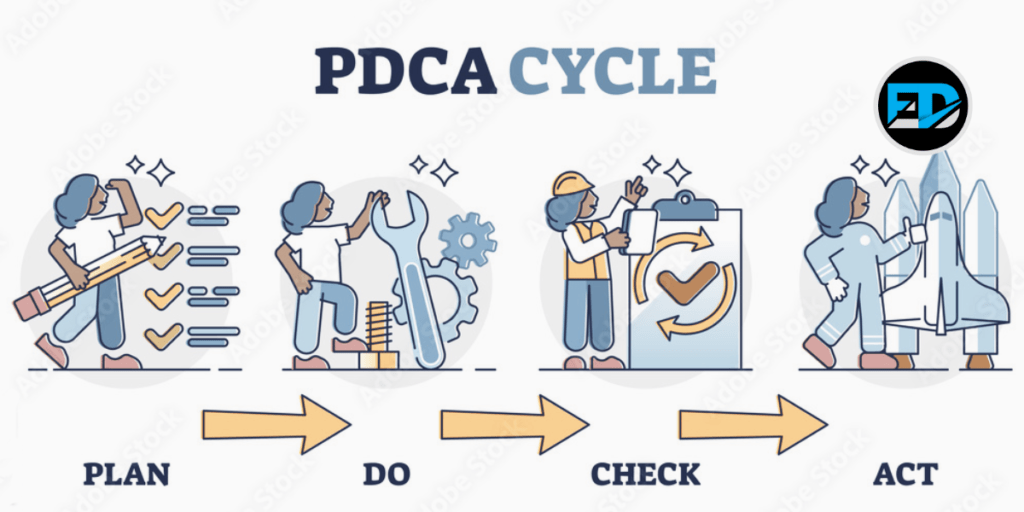Introduction to PDCA Cycle
The PDCA (Plan-Do-Check-Act) cycle is a vital methodology for achieving continuous improvement in various domains, including software development. Originating from the principles of quality control, the PDCA cycle, also known as the Deming Cycle, was popularized by Dr. W. Edwards Deming, a prominent figure in the field of quality management. The cycle’s primary purpose is to foster a systematic and iterative approach to problem-solving and process enhancement.
Definition
The PDCA cycle is a four-step model that provides a structured framework for identifying and solving problems through continuous feedback and refinement. Each phase—Plan, Do, Check, and Act—plays a crucial role in driving incremental improvements.
History
The roots of the PDCA cycle can be traced back to the early 20th century. Dr. Deming adapted the original concept from the Shewhart Cycle, named after Walter A. Shewhart, a pioneer in quality control. Deming’s adaptation emphasized iterative progress and became a cornerstone of quality management practices globally.
Importance
In software development, the PDCA cycle offers a methodical approach to enhancing processes, ensuring quality, and delivering value to stakeholders. By continuously evaluating and refining processes, development teams can achieve higher efficiency, better product quality, and increased customer satisfaction.
PDCA Cycle in Software Development

The PDCA cycle’s application in software development is crucial for fostering a culture of continuous improvement. It ensures that development processes are systematically evaluated, refined, and optimized to meet evolving requirements and expectations.
Overview
In the context of software development, the PDCA cycle enables teams to break down complex processes into manageable steps. This iterative approach helps identify issues early, implement corrective actions, and continuously improve the quality and performance of software products.
Key Concepts
- Plan: Establish objectives and processes necessary to deliver the desired outcomes.
- Do: Implement the plan, execute the processes, and create the product.
- Check: Monitor and evaluate the processes and results against the objectives.
- Act: Take actions to standardize successful processes and address any deficiencies.
Plan Phase
The Plan phase is the foundation of the PDCA cycle, setting the stage for all subsequent activities. It involves thorough planning, goal setting, and process analysis to ensure that development efforts are aligned with desired outcomes.
Identifying Goals
Establishing clear, measurable goals is essential for guiding the development process. Goals should be aligned with business objectives, customer needs, and technical requirements. This step involves collaboration among stakeholders to define priorities and set realistic targets.
Analyzing Current Processes
A comprehensive analysis of existing processes helps identify areas for improvement. Techniques such as SWOT analysis (Strengths, Weaknesses, Opportunities, Threats) and process mapping are useful for understanding the current state and pinpointing inefficiencies.
Planning Improvements
Based on the analysis, teams can develop detailed plans for implementing improvements. This includes defining tasks, assigning responsibilities, setting timelines, and identifying necessary resources. Risk assessment and mitigation strategies should also be considered to address potential challenges.
Do Phase
The Do phase focuses on executing the planned improvements. It involves implementing changes, documenting processes, and fostering collaboration among team members.
Implementing Changes
Changes should be implemented in a controlled manner, ensuring that all team members are aware of their roles and responsibilities. Clear communication and coordination are crucial for successful implementation.
Documentation
Documenting the processes and changes is vital for maintaining transparency and ensuring that improvements can be replicated and scaled. This includes creating detailed records of tasks, procedures, and outcomes.
Team Collaboration
Collaboration among team members is essential for effective execution. Regular meetings, progress updates, and collaborative tools can facilitate communication and ensure that everyone is aligned with the goals.
Check Phase
The Check phase involves monitoring and evaluating the outcomes of the implemented changes. This step is critical for understanding the effectiveness of the improvements and identifying areas for further refinement.
Monitoring Results
Continuous monitoring of results helps track progress and identify any deviations from the plan. Metrics such as performance indicators, quality measures, and customer feedback are valuable for assessing the impact of changes.
Analyzing Data
Data analysis is crucial for evaluating the success of the improvements. Techniques such as statistical analysis, trend analysis, and root cause analysis can provide insights into the effectiveness of the changes and highlight areas for further enhancement.
Feedback Collection
Collecting feedback from stakeholders, including team members and customers, provides valuable insights into the impact of the changes. This feedback can guide future improvements and ensure that development efforts are aligned with user needs.
Act Phase
The Act phase focuses on standardizing successful changes and addressing any issues identified during the Check phase. This step ensures that improvements are integrated into the development process and that lessons learned are applied to future cycles.
Standardizing Successful Changes
Successful changes should be documented and standardized to ensure consistent application across the development process. This involves updating process documentation, training team members, and integrating improvements into standard operating procedures.
Addressing Issues
Any issues identified during the Check phase should be addressed promptly. This includes developing corrective actions, revising plans, and implementing necessary adjustments to ensure continuous improvement.
Preparing for Next Cycle
The PDCA cycle is iterative, and preparing for the next cycle involves reviewing the outcomes of the current cycle, identifying new areas for improvement, and setting goals for the next iteration. This continuous loop drives ongoing enhancement and innovation.
Importance of Continuous Improvement
Continuous improvement is a cornerstone of successful software development. It ensures that development processes remain efficient, adaptable, and capable of delivering high-quality products that meet evolving customer needs.
Benefits
- Enhanced Quality: Continuous refinement of processes leads to higher quality products with fewer defects and issues.
- Increased Efficiency: Streamlined processes and improved workflows result in faster development cycles and reduced time-to-market.
- Greater Customer Satisfaction: By continuously addressing customer feedback and improving product features, development teams can enhance user experiences and satisfaction.
Challenges
- Resource Allocation: Continuous improvement requires dedicated resources, including time, personnel, and tools.
- Change Management: Implementing changes can be challenging, particularly in larger organizations with established processes and cultures.
- Sustaining Momentum: Maintaining a culture of continuous improvement requires ongoing commitment and engagement from all team members.
Case Studies
Real-world examples of successful PDCA implementation in software development highlight the tangible benefits of this approach. These case studies provide valuable insights into best practices, challenges, and outcomes achieved through continuous improvement efforts.
Implementing PDCA in Agile Methodology
Agile methodology and the PDCA cycle share common principles of iterative progress, continuous feedback, and adaptability. Integrating PDCA into Agile practices can enhance the effectiveness of both approaches, leading to improved development outcomes.
Integration with Agile
The PDCA cycle can be seamlessly integrated into Agile frameworks such as Scrum, Kanban, and XP (Extreme Programming). By incorporating PDCA principles into Agile ceremonies (e.g., sprints, retrospectives), teams can enhance their ability to identify and implement improvements.
Scrum and PDCA
In Scrum, the PDCA cycle can be applied at various levels, including sprint planning, daily stand-ups, sprint reviews, and retrospectives. This integration ensures that continuous improvement is embedded in the development process, driving ongoing enhancement and innovation.
Benefits of Combining Both
Combining PDCA with Agile practices offers several benefits:
- Enhanced Flexibility: The iterative nature of both approaches allows teams to adapt quickly to changes and respond to new information.
- Improved Collaboration: Continuous feedback and regular communication foster better collaboration among team members and stakeholders.
- Greater Focus on Quality: The emphasis on continuous improvement ensures that quality is a top priority throughout the development process.
Tools and Techniques
Effective implementation of the PDCA cycle in software development requires the use of various tools and techniques. These resources facilitate planning, execution, monitoring, and analysis of improvement efforts.
Software Tools
Several software tools support the PDCA cycle in software development. These tools provide functionalities for project management, collaboration, data analysis, and documentation. Examples include:
- JIRA: A popular tool for Agile project management that supports sprint planning, issue tracking, and reporting.
- Trello: A visual project management tool that helps teams organize tasks, collaborate, and track progress.
- Asana: A versatile project management tool that facilitates task management, collaboration, and reporting.
Data Analysis Methods
Data analysis is critical for evaluating the effectiveness of improvements. Techniques such as statistical analysis, trend analysis, and root cause analysis provide valuable insights into process performance and areas for enhancement.
Documentation Techniques
Effective documentation ensures transparency and facilitates the replication of successful processes. Techniques such as process mapping, flowcharts, and standard operating procedures (SOPs) help document tasks, procedures, and outcomes.
Case Study: Successful PDCA Implementation
A real-world case study of successful PDCA implementation in software development illustrates the practical application of this methodology. This example provides insights into the steps followed, challenges encountered, and results achieved through continuous improvement efforts.
Real-World Example
In this case study, a software development team faced challenges with long development cycles and frequent defects. By implementing the PDCA cycle, the team systematically identified issues, implemented changes, and monitored results.
Steps Followed
- Plan: The team conducted a thorough analysis of current processes and identified key areas for improvement, including code quality and testing procedures.
- Do: Changes were implemented, such as adopting automated testing tools and enhancing code review practices.
- Check: The team monitored the impact of these changes, analyzing defect rates and development cycle times.
- Act: Successful changes were standardized, and lessons learned were applied to future cycles.
Results Achieved
The implementation of the PDCA cycle led to significant improvements, including reduced defect rates, shorter development cycles, and higher customer satisfaction. The team’s commitment to continuous improvement ensured ongoing enhancement of their processes and products.
Challenges and Solutions
Implementing the PDCA cycle in software development can present several challenges. However, with the right strategies and best practices, these obstacles can be effectively addressed.
Common Obstacles
- Resistance to Change: Team members may be resistant to new processes and changes in workflow.
- Resource Constraints: Limited resources, including time, personnel, and tools, can hinder continuous improvement efforts.
- Complexity: Managing and coordinating improvement efforts can be complex, particularly in large projects or organizations.
Overcoming Challenges
- Communication: Clear communication and involvement of all team members can help overcome resistance to change.
- Prioritization: Focusing on high-impact improvements and allocating resources strategically can address resource constraints.
- Simplification: Breaking down complex processes into manageable steps and using effective project management techniques can reduce complexity.
Best Practices
- Engage Stakeholders: Involving stakeholders in planning and decision-making ensures that improvements are aligned with business objectives and user needs.
- Continuous Learning: Encouraging a culture of learning and development helps team members stay updated with best practices and new methodologies.
- Regular Reviews: Conducting regular reviews and retrospectives allows teams to assess progress, identify issues, and plan future improvements.
Measuring Success
Measuring the success of continuous improvement efforts is essential for understanding their impact and guiding future initiatives. Key performance indicators (KPIs) and metrics provide valuable insights into the effectiveness of the PDCA cycle.
Key Performance Indicators
KPIs such as defect rates, development cycle times, and customer satisfaction scores help measure the impact of improvements. These indicators provide a clear picture of progress and highlight areas for further enhancement.
Metrics for Continuous Improvement
Metrics such as lead time, cycle time, and code quality are useful for evaluating the effectiveness of improvement efforts. These metrics provide quantitative data that can guide decision-making and prioritize future initiatives.
Feedback Loops
Establishing feedback loops ensures that continuous improvement efforts are informed by real-time data and stakeholder input. Regular feedback from team members, customers, and other stakeholders provides valuable insights into the impact of changes and areas for further refinement.
PDCA and Lean Software Development
The principles of PDCA and Lean software development share common goals of eliminating waste, optimizing processes, and delivering value to customers. Integrating these methodologies can enhance the effectiveness of continuous improvement efforts.
Synergies
The iterative nature of the PDCA cycle complements the principles of Lean, such as continuous flow, just-in-time delivery, and waste reduction. Together, these methodologies promote a culture of continuous improvement and efficiency.
Principles of Lean
Lean principles, including value stream mapping, kanban, and kaizen, align with the PDCA cycle’s focus on continuous improvement. These principles help identify inefficiencies, streamline processes, and enhance product quality.
Application in Software Development
Applying Lean principles in software development involves practices such as reducing work in progress (WIP), optimizing workflows, and focusing on customer value. The PDCA cycle provides a structured framework for implementing these practices and driving continuous improvement.
Real-World Applications of PDCA in Software
Real-world applications of the PDCA cycle in software development highlight its effectiveness in driving continuous improvement and delivering high-quality products.
Industry Examples
Various industries, including finance, healthcare, and technology, have successfully applied the PDCA cycle in software development. These examples provide valuable insights into best practices, challenges, and outcomes achieved through continuous improvement efforts.
Lessons Learned
Lessons learned from real-world applications of the PDCA cycle include the importance of stakeholder involvement, the value of data-driven decision-making, and the need for ongoing commitment to continuous improvement.
Best Practices
Best practices for applying the PDCA cycle in software development include:
- Engage Stakeholders: Involve stakeholders in planning and decision-making to ensure alignment with business objectives and user needs.
- Use Data: Leverage data and metrics to guide decision-making and prioritize improvement efforts.
- Foster a Culture of Improvement: Encourage a culture of continuous learning and development to sustain ongoing enhancement efforts.
Training and Skill Development
Effective implementation of the PDCA cycle requires training and skill development for team members. Investing in these areas ensures that teams are equipped with the knowledge and skills necessary for continuous improvement.
Importance of Training
Training programs provide team members with the skills and knowledge needed to apply the PDCA cycle effectively. These programs can cover topics such as quality management, data analysis, and project management.
Skill Development Programs
Skill development programs, including workshops, seminars, and online courses, help team members stay updated with best practices and new methodologies. These programs promote a culture of continuous learning and improvement.
Resources
Various resources, including books, articles, and online courses, are available to support training and skill development in the PDCA cycle. These resources provide valuable insights, techniques, and case studies to guide continuous improvement efforts.
Role of Leadership in PDCA
Leadership plays a critical role in the successful implementation of the PDCA cycle. Effective leadership strategies help build a culture of continuous improvement and motivate teams to achieve their goals.
Leadership Strategies
Leadership strategies for promoting continuous improvement include:
- Setting Clear Goals: Establishing clear, measurable goals provides direction and focus for improvement efforts.
- Encouraging Collaboration: Fostering a collaborative environment promotes teamwork and ensures that all team members are aligned with the goals.
- Providing Support: Providing the necessary resources, including time, tools, and training, supports continuous improvement efforts.
Building a Culture of Continuous Improvement
Building a culture of continuous improvement involves promoting the values of quality, efficiency, and innovation. Leadership plays a crucial role in establishing these values and motivating team members to embrace continuous improvement.
Motivating Teams
Motivating teams to engage in continuous improvement requires recognizing and rewarding their efforts, providing opportunities for growth and development, and fostering a positive work environment.
Continuous Improvement Culture
Establishing a culture of continuous improvement is essential for sustaining long-term success in software development. This culture promotes ongoing enhancement, innovation, and efficiency.
Establishing a Culture
Establishing a culture of continuous improvement involves promoting the values of quality, efficiency, and innovation. This requires ongoing commitment from leadership and team members, as well as the implementation of best practices and methodologies.
Team Involvement
Involving team members in continuous improvement efforts ensures that their insights and feedback are incorporated into the process. This promotes a sense of ownership and accountability, driving ongoing enhancement.
Long-Term Commitment
Sustaining a culture of continuous improvement requires long-term commitment from all team members. This involves regularly reviewing and refining processes, setting new goals, and maintaining a focus on quality and efficiency.
Future Trends in PDCA
The future of PDCA in software development is shaped by emerging trends and technological advances. These trends provide new opportunities for continuous improvement and innovation.
Emerging Trends
Emerging trends in PDCA and software development include the use of artificial intelligence (AI), machine learning, and automation to enhance processes and drive continuous improvement.
Technological Advances
Technological advances, such as advanced data analytics and cloud computing, provide new tools and techniques for implementing the PDCA cycle. These technologies enable more efficient monitoring, analysis, and refinement of processes.
Future Prospects
The future prospects of PDCA in software development are promising, with ongoing advancements in technology and methodologies. By embracing these trends, development teams can continue to drive continuous improvement and deliver high-quality products.
Conclusion
The PDCA cycle is a powerful methodology for achieving continuous improvement in software development. By systematically planning, executing, monitoring, and refining processes, development teams can enhance efficiency, quality, and customer satisfaction. Embracing the principles of the PDCA cycle, integrating it with Agile practices, and fostering a culture of continuous improvement ensure long-term success and innovation in the ever-evolving field of software development.
FAQs
The PDCA cycle is a four-step model for continuous improvement in software development, involving planning, executing, monitoring, and refining processes.
The PDCA cycle helps improve process efficiency, product quality, and customer satisfaction by promoting continuous evaluation and refinement of development practices.
Yes, the PDCA cycle can be integrated with Agile methodology to enhance iterative progress, continuous feedback, and adaptability in software development.
The key phases of the PDCA cycle are Plan, Do, Check, and Act, each focusing on different aspects of problem-solving and process improvement.
Success can be measured using key performance indicators (KPIs), metrics for continuous improvement, and feedback from stakeholders to evaluate the impact of changes.
Challenges include resistance to change, resource constraints, and the complexity of managing improvement efforts, which can be addressed through effective communication, prioritization, and simplification.






Leave a Reply
You must be logged in to post a comment.